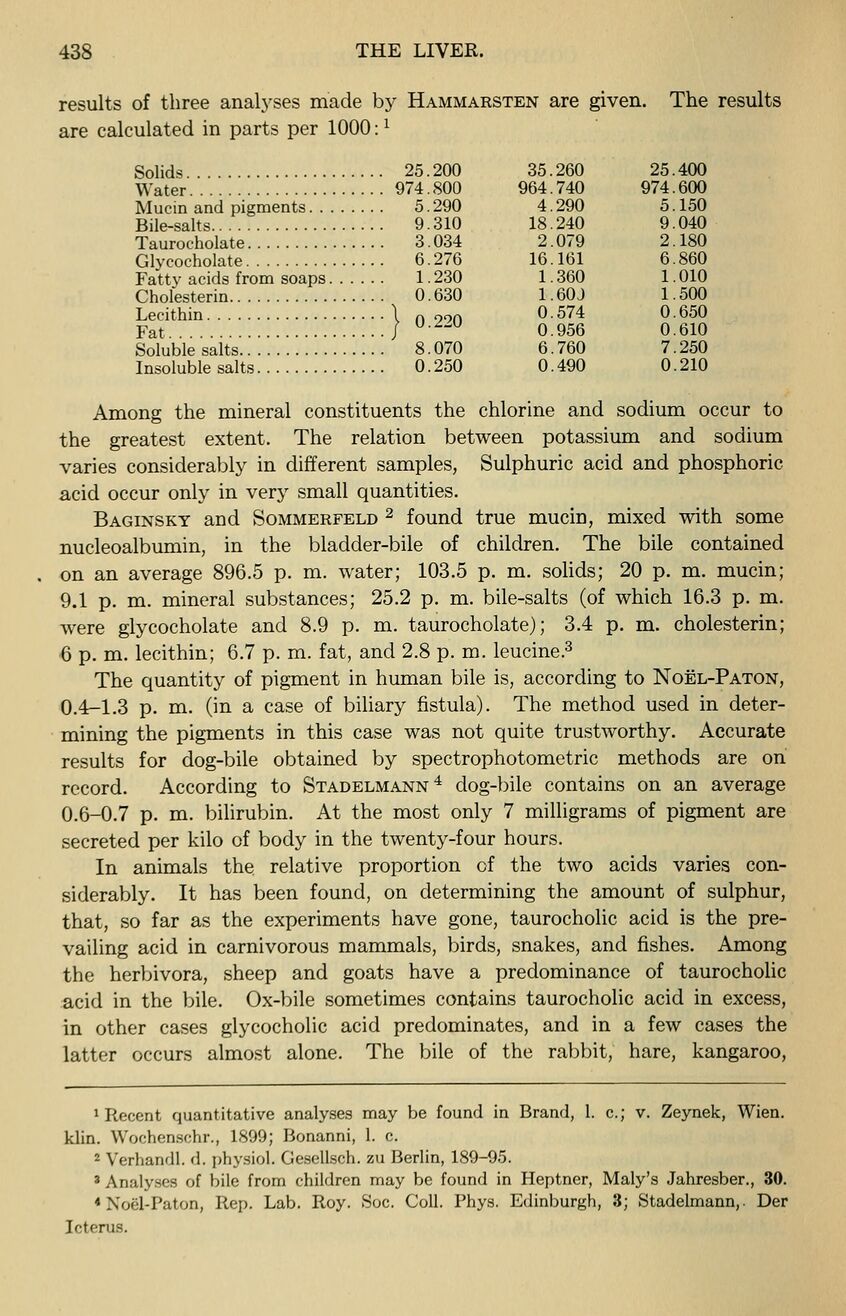
Full resolution (JPEG) - On this page / på denna sida - VII. The Liver - The Bile and its Formation

<< prev. page << föreg. sida << >> nästa sida >> next page >>
Below is the raw OCR text
from the above scanned image.
Do you see an error? Proofread the page now!
Här nedan syns maskintolkade texten från faksimilbilden ovan.
Ser du något fel? Korrekturläs sidan nu!
This page has never been proofread. / Denna sida har aldrig korrekturlästs.
438 THE LIVER.
results of three analyses made by Hammarsten are given. The results
are calculated in parts per 1000
:
l
Solids 25.200 35.260 25.400
Water 974.800 964.740 974.600
Mucin and pigments 5 . 290 4 . 290 5 . 150
Bile-salts 9.310 18.240 9.040
Taurocholate 3.034 2.079 2.180
Glycocholate 6.276 16.161 6.860
Fattv acids from soaps 1 . 230 1 . 360 1 .
010
Cholesterin 0.630 1.60J 1.500
Lecithin \ n 990 0574 °- 650
Fat J 0.956 0.610
Soluble salts 8.070 6.760 7.250
Insoluble salts 0.250 0.490 0.210
Among the mineral constituents the chlorine and sodium occur to
the greatest extent. The relation between potassium and sodium
varies considerably in different samples, Sulphuric acid and phosphoric
acid occur only in very small quantities.
Baginskt and Sommerfeld 2
found true mucin, mixed with some
nucleoalbumin, in the bladder-bile of children. The bile contained
on an average 896.5 p. m. water; 103.5 p. m. solids; 20 p. m. mucin;
9.1 p. m. mineral substances; 25.2 p. m. bile-salts (of which 16.3 p. m.
were glycocholate and 8.9 p. m. taurocholate); 3.4 p. m. cholesterin;
6 p. m. lecithin; 6.7 p. m. fat, and 2.8 p. m. leucine.3
The quantity of pigment in human bile is, according to Noel-Paton,
0.4-1.3 p. m. (in a case of biliary fistula). The method used in deter-
mining the pigments in this case was not quite trustworthy. Accurate
results for dog-bile obtained by spectrophotometric methods are on
record. According to Stadelmann 4
dog-bile contains on an average
0.6-0.7 p. m. bilirubin. At the most only 7 milligrams of pigment are
secreted per kilo of body in the twenty-four hours.
In animals the. relative proportion of the two acids varies con-
siderably. It has been found, on determining the amount of sulphur,
that, so far as the experiments have gone, taurocholic acid is the pre-
vailing acid in carnivorous mammals, birds, snakes, and fishes. Among
the herbivora, sheep and goats have a predominance of taurocholic
acid in the bile. Ox-bile sometimes contains taurocholic acid in excess,
in other cases glycocholic acid predominates, and in a few cases the
latter occurs almost alone. The bile of the rabbit, hare, kangaroo,
decent quantitative analyses may be found in Brand, 1. c; v. Zeynek, Wien.
klin. Wochensehr., 1899; Bonanni, 1. c.
2
Verhandl. d. physiol. Gesellsch. zu Berlin, 189-95.
3 Analyses of bile from children may be found in Heptner, Maly’s Jahresber., 30.
4
Noel-Paton, Rep. Lab. Roy. Soc. Coll. Phys. Edinburgh, 3; Stadelmann,. Der
Icterus.
<< prev. page << föreg. sida << >> nästa sida >> next page >>